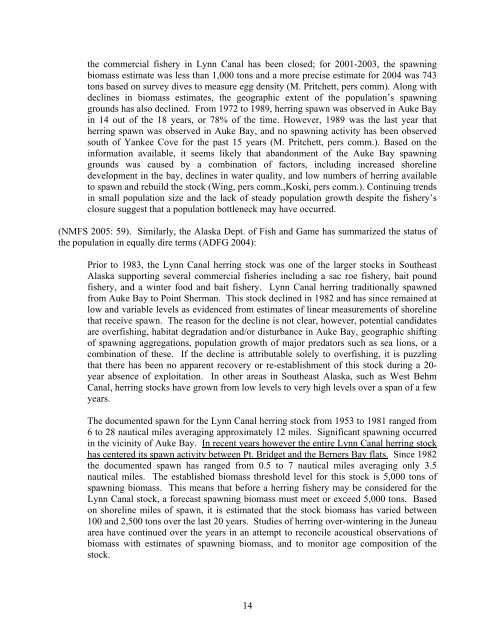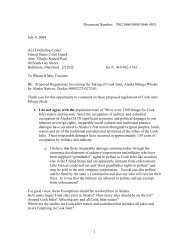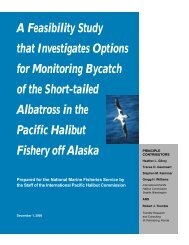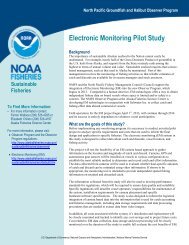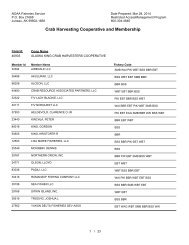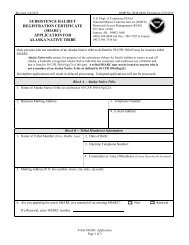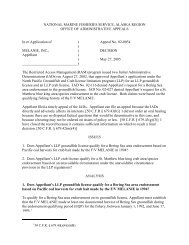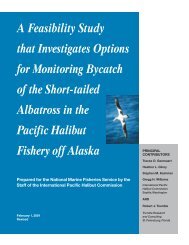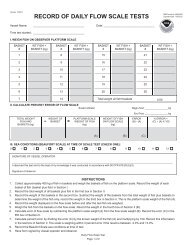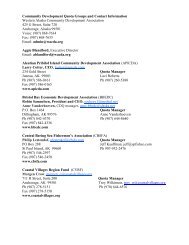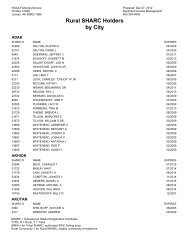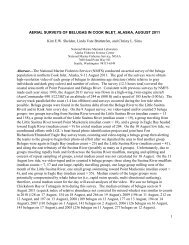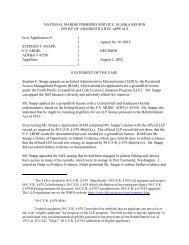Petition to List Lynn Canal Pacific Herring under the Endangered ...
Petition to List Lynn Canal Pacific Herring under the Endangered ...
Petition to List Lynn Canal Pacific Herring under the Endangered ...
Create successful ePaper yourself
Turn your PDF publications into a flip-book with our unique Google optimized e-Paper software.
<strong>the</strong> commercial fishery in <strong>Lynn</strong> <strong>Canal</strong> has been closed; for 2001-2003, <strong>the</strong> spawning<br />
biomass estimate was less than 1,000 <strong>to</strong>ns and a more precise estimate for 2004 was 743<br />
<strong>to</strong>ns based on survey dives <strong>to</strong> measure egg density (M. Pritchett, pers comm). Along with<br />
declines in biomass estimates, <strong>the</strong> geographic extent of <strong>the</strong> population’s spawning<br />
grounds has also declined. From 1972 <strong>to</strong> 1989, herring spawn was observed in Auke Bay<br />
in 14 out of <strong>the</strong> 18 years, or 78% of <strong>the</strong> time. However, 1989 was <strong>the</strong> last year that<br />
herring spawn was observed in Auke Bay, and no spawning activity has been observed<br />
south of Yankee Cove for <strong>the</strong> past 15 years (M. Pritchett, pers comm.). Based on <strong>the</strong><br />
information available, it seems likely that abandonment of <strong>the</strong> Auke Bay spawning<br />
grounds was caused by a combination of fac<strong>to</strong>rs, including increased shoreline<br />
development in <strong>the</strong> bay, declines in water quality, and low numbers of herring available<br />
<strong>to</strong> spawn and rebuild <strong>the</strong> s<strong>to</strong>ck (Wing, pers comm.,Koski, pers comm.). Continuing trends<br />
in small population size and <strong>the</strong> lack of steady population growth despite <strong>the</strong> fishery’s<br />
closure suggest that a population bottleneck may have occurred.<br />
(NMFS 2005: 59). Similarly, <strong>the</strong> Alaska Dept. of Fish and Game has summarized <strong>the</strong> status of<br />
<strong>the</strong> population in equally dire terms (ADFG 2004):<br />
Prior <strong>to</strong> 1983, <strong>the</strong> <strong>Lynn</strong> <strong>Canal</strong> herring s<strong>to</strong>ck was one of <strong>the</strong> larger s<strong>to</strong>cks in Sou<strong>the</strong>ast<br />
Alaska supporting several commercial fisheries including a sac roe fishery, bait pound<br />
fishery, and a winter food and bait fishery. <strong>Lynn</strong> <strong>Canal</strong> herring traditionally spawned<br />
from Auke Bay <strong>to</strong> Point Sherman. This s<strong>to</strong>ck declined in 1982 and has since remained at<br />
low and variable levels as evidenced from estimates of linear measurements of shoreline<br />
that receive spawn. The reason for <strong>the</strong> decline is not clear, however, potential candidates<br />
are overfishing, habitat degradation and/or disturbance in Auke Bay, geographic shifting<br />
of spawning aggregations, population growth of major preda<strong>to</strong>rs such as sea lions, or a<br />
combination of <strong>the</strong>se. If <strong>the</strong> decline is attributable solely <strong>to</strong> overfishing, it is puzzling<br />
that <strong>the</strong>re has been no apparent recovery or re-establishment of this s<strong>to</strong>ck during a 20-<br />
year absence of exploitation. In o<strong>the</strong>r areas in Sou<strong>the</strong>ast Alaska, such as West Behm<br />
<strong>Canal</strong>, herring s<strong>to</strong>cks have grown from low levels <strong>to</strong> very high levels over a span of a few<br />
years.<br />
The documented spawn for <strong>the</strong> <strong>Lynn</strong> <strong>Canal</strong> herring s<strong>to</strong>ck from 1953 <strong>to</strong> 1981 ranged from<br />
6 <strong>to</strong> 28 nautical miles averaging approximately 12 miles. Significant spawning occurred<br />
in <strong>the</strong> vicinity of Auke Bay. In recent years however <strong>the</strong> entire <strong>Lynn</strong> <strong>Canal</strong> herring s<strong>to</strong>ck<br />
has centered its spawn activity between Pt. Bridget and <strong>the</strong> Berners Bay flats. Since 1982<br />
<strong>the</strong> documented spawn has ranged from 0.5 <strong>to</strong> 7 nautical miles averaging only 3.5<br />
nautical miles. The established biomass threshold level for this s<strong>to</strong>ck is 5,000 <strong>to</strong>ns of<br />
spawning biomass. This means that before a herring fishery may be considered for <strong>the</strong><br />
<strong>Lynn</strong> <strong>Canal</strong> s<strong>to</strong>ck, a forecast spawning biomass must meet or exceed 5,000 <strong>to</strong>ns. Based<br />
on shoreline miles of spawn, it is estimated that <strong>the</strong> s<strong>to</strong>ck biomass has varied between<br />
100 and 2,500 <strong>to</strong>ns over <strong>the</strong> last 20 years. Studies of herring over-wintering in <strong>the</strong> Juneau<br />
area have continued over <strong>the</strong> years in an attempt <strong>to</strong> reconcile acoustical observations of<br />
biomass with estimates of spawning biomass, and <strong>to</strong> moni<strong>to</strong>r age composition of <strong>the</strong><br />
s<strong>to</strong>ck.<br />
14


